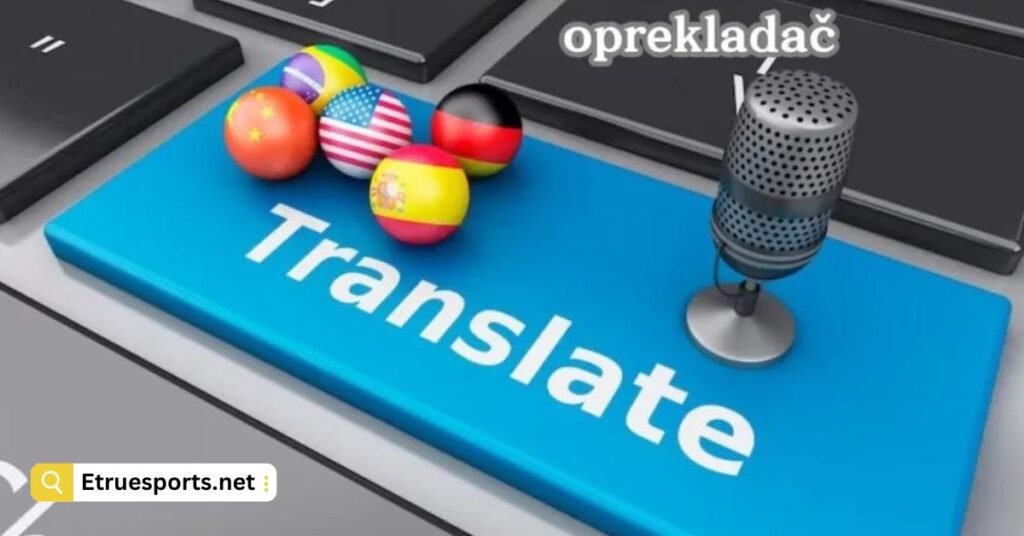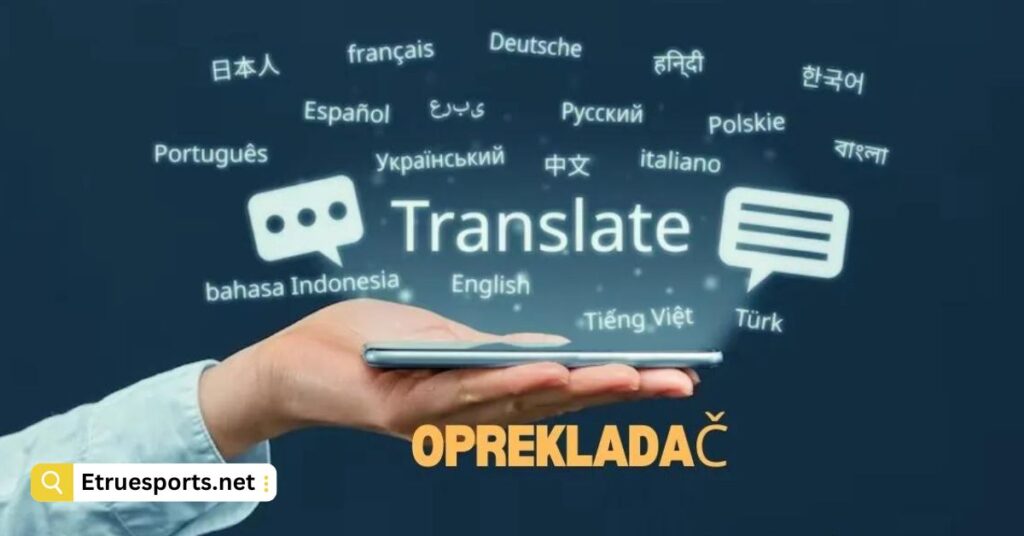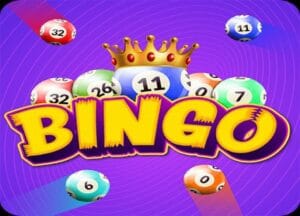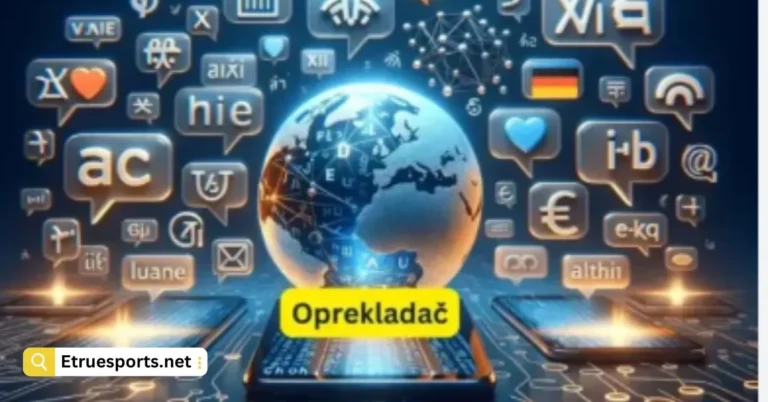Language is an intrinsic part of human society, and as globalization advances, the need to bridge linguistic barriers becomes ever more critical. Technology has played a pivotal role in facilitating cross-lingual communication, and within this realm, tools like Oprekladač have emerged as essential instruments. This article delves into what Oprekladač represents, its functionality, its historical development, and the broader impact of machine translation on society.
What is Oprekladač?
The Definition of Oprekladač
The term “Oprekladač” stems from the Czech word for “translator” or “interpreter.” It refers to a digital or automated tool designed to facilitate the translation of text or speech from one language into another. Oprekladač tools are often powered by machine learning algorithms and artificial intelligence, which allow them to understand and convert languages with increasing accuracy.
The Basic Functionality of Oprekladač
Oprekladač operates on a principle of translating words and sentences by analyzing input text and applying linguistic patterns that are learned from massive datasets. Modern Oprekladač tools utilize neural networks to process data and generate translations that closely reflect human language use.
Key functionalities of Oprekladač include:
Text-to-text translation
This is the primary function, where the tool translates a block of written text from a source language into a target language.
Speech-to-text translation
This feature allows spoken words to be translated and rendered in written form, making real-time conversations possible across language barriers.
Speech-to-speech translation
Some advanced Oprekladač tools can translate speech in real-time, maintaining the spoken form throughout the process.
Multi-lingual capabilities
Oprekladač tools are often designed to work with a wide range of languages, making them valuable tools for international communication.
Historical Development of Oprekladač
Early Efforts in Machine Translation
The roots of Oprekladač and similar translation tools can be traced back to the early attempts at machine translation in the mid-20th century. Pioneering efforts like the Georgetown-IBM experiment in 1954 were instrumental in showing that computers could be used to translate languages, albeit with limited success at the time.
In these early stages, translations were primarily rule-based. Linguists and computer scientists collaborated to create algorithms that could follow grammatical rules and produce rough translations. However, these early systems struggled with nuances, idiomatic expressions, and the overall fluidity of language, making their outputs often unintelligible.
The Introduction of Statistical Machine Translation (SMT)
The real breakthrough came in the 1990s when statistical machine translation (SMT) was introduced. This method relied on vast amounts of bilingual text to generate translations based on the probability of word correspondences between languages. The more data the system processed, the more accurate the translations became.
SMT represented a major leap forward, but it still had its limitations. Although statistical models could produce more natural translations, they often failed with context, sentence structure, and languages with complex grammatical rules.
Neural Machine Translation (NMT) and the Modern Era
By the 2010s, the development of neural machine translation (NMT) marked another leap in the evolution of Oprekladač technology. NMT uses deep learning techniques, particularly neural networks, to mimic the way the human brain processes language. Unlike SMT, which broke down translations into smaller parts, NMT processes entire sentences at once, allowing it to better understand context and semantics.
The advent of Google Translate and other similar platforms brought machine translation into the mainstream, making Oprekladač tools easily accessible to the general public. Today’s Oprekladač tools are capable of producing near-human-level translations, with continuous improvements driven by advances in AI and access to ever-growing datasets.
How Oprekladač Works: A Deep Dive into Machine Translation

Understanding Neural Networks
The key to the success of modern Oprekladač systems is the neural network. Neural networks are complex systems of algorithms that are designed to recognize patterns in data. In the case of language translation, they analyze the patterns in the relationships between words and phrases in different languages.
Neural networks used in Oprekladač tools typically consist of encoder-decoder architecture:
The encoder processes the input sentence in the source language and converts it into a set of numerical representations, often referred to as “embeddings.”
The decoder takes these embeddings and generates an output sentence in the target language, based on the patterns it has learned from training data.
Training the Models
For Oprekladač to work effectively, the neural networks must be trained on large corpora of bilingual text. During the training process, the system learns to associate words, phrases, and grammar rules from the source language with their equivalents in the target language. This training phase is data-intensive, requiring millions of sentences across a variety of languages and dialects.
Challenges in Translation
While neural machine translation has vastly improved the accuracy of translations, it is not without its challenges. Some of the key difficulties faced by Oprekladač tools include:
Idiomatic expressions
Languages are rich in idiomatic phrases, and translating these literally can lead to misunderstandings.
Cultural context
Language is deeply tied to culture, and certain words or phrases may not have direct equivalents in other languages.
Grammatical structure
Different languages have different sentence structures, which can complicate translation efforts.
Ambiguity
Words can have multiple meanings, and understanding which meaning is intended requires a deep understanding of context.
Applications of Oprekladač in Today’s World
Cross-Lingual Communication
The primary use of Oprekladač is to bridge communication gaps in a multilingual world. It enables individuals who speak different languages to communicate more easily and effectively. In the business world, Oprekladač tools have become essential for companies that operate globally, allowing them to communicate with clients, partners, and employees in different parts of the world.
Academic and Research Collaboration
Oprekladač tools have also become valuable in the academic sphere, enabling researchers from different countries to collaborate without the hindrance of language barriers. For example, scientific papers and research findings can be translated and shared more easily, promoting cross-border collaboration and knowledge exchange.
Education and Language Learning
Oprekladač is increasingly being used as a tool for language learners. By providing instant translations, learners can better understand foreign languages and improve their vocabulary. Additionally, educators can use these tools to create multilingual resources for students, making education more accessible in diverse linguistic environments.
Real-Time Translation for Travel and Tourism
For travelers, Oprekladač has become an indispensable tool. It allows tourists to navigate foreign countries, understand signs, communicate with locals, and access information in unfamiliar languages. Whether it’s ordering food in a restaurant or asking for directions, Oprekladač makes traveling more convenient and less intimidating.
Future Trends and Developments in Oprekladač Technology

Integration with Augmented Reality (AR) and Virtual Reality (VR)
The next frontier for Oprekladač tools is the integration with augmented reality (AR) and virtual reality (VR) technologies. Imagine wearing AR glasses that can translate signs or menus in real-time as you view them, or using VR to attend international conferences where all participants can speak in their native languages while understanding each other perfectly through seamless translation.
Enhanced Voice Recognition and Speech Translation
As speech recognition technology continues to improve, Oprekladač tools are likely to become even more proficient at real-time spoken translation. This could make international business meetings, diplomatic discussions, and everyday conversations between speakers of different languages smoother and more natural.
Personalization and Contextual Understanding
One area of future development is the personalization of translations. Current Oprekladač systems provide generic translations, but in the future, these systems may be able to tailor translations based on individual preferences, dialects, or contexts. This would involve greater contextual understanding, where the system not only translates words but also adapts to the cultural nuances and communication styles of the user.
Ethical Considerations in Machine Translation
As Oprekladač tools become more prevalent, ethical considerations must also be addressed. These include concerns about the potential loss of jobs in translation and interpreting, the accuracy of translations in sensitive or legal contexts, and the risk of reinforcing biases present in the training data.
The Impact of Oprekladač on Language and Society
Preserving Minority Languages
While machine translation has traditionally focused on major world languages, there is growing interest in using Oprekladač tools to help preserve and promote minority languages. By creating resources for these languages and making them more accessible online, Oprekladač technology could play a role in revitalizing languages that are at risk of extinction.
Language Evolution and Change
As Oprekladač tools become more widespread, they could influence the way languages evolve. For instance, increased interaction between speakers of different languages might lead to the borrowing of words, the simplification of certain grammatical structures, or the blending of linguistic features.
Digital Divide and Access to Information
Oprekladač also has the potential to reduce the digital divide by making information accessible to people who speak less common languages. In a world where most digital content is produced in English or a handful of other languages, Oprekladač tools can democratize access to knowledge and resources for speakers of underrepresented languages.
FAQs
1. What is Oprekladač, and how does it work?
Oprekladač is a digital translation tool that translates text or speech from one language to another using advanced algorithms, such as neural networks. It works by analyzing input data, identifying linguistic patterns, and generating translations based on vast datasets. Modern Oprekladač tools can handle text-to-text, speech-to-text, and speech-to-speech translations.
2. How accurate are Oprekladač translations?
The accuracy of Oprekladač translations depends on the complexity of the language and context. While neural machine translation (NMT) systems offer more accurate and natural translations than earlier models, they can still struggle with idiomatic expressions, cultural nuances, and highly technical or ambiguous content.
3. Can Oprekladač be used for real-time communication?
Yes, many Oprekladač tools support real-time translation for both text and speech, making them ideal for live conversations, international meetings, or travel. Speech-to-speech translation allows users to communicate across languages in real time, though the quality may vary based on the languages and speech recognition technology.
4. How is Oprekladač different from other translation tools?
Oprekladač, like other machine translation tools, uses neural machine translation models, but the term specifically refers to a class of Czech translation tools or those inspired by it. Its performance and feature set are similar to widely known tools like Google Translate, focusing on multilingual support, real-time translation, and integrating AI for better context understanding.
5. What languages does Oprekladač support?
Oprekladač tools generally support a wide range of languages, from major global languages like English, Spanish, and Chinese to regional and minority languages. However, the level of translation accuracy may differ depending on the availability of data for training in specific languages. Some Oprekladač systems are actively expanding support for lesser-known or endangered languages.
Conclusion
Oprekladač represents a significant advancement in technology that is reshaping the way we communicate across linguistic boundaries. With its growing capabilities, Oprekladač is not just a tool for translation—it is becoming a crucial bridge in a world that is increasingly interconnected and diverse. From enabling cross-cultural communication to preserving endangered languages, It is poised to play a central role in shaping the future of global interaction. As the technology continues to evolve, it will open up new possibilities for communication, collaboration, and understanding, creating a world where language is no longer a barrier but a bridge to connection.








